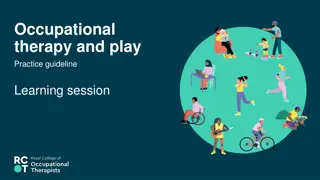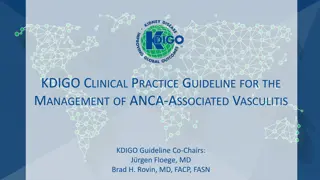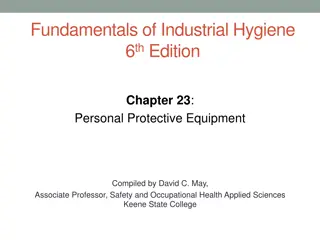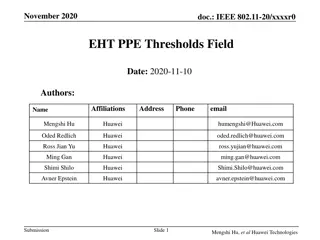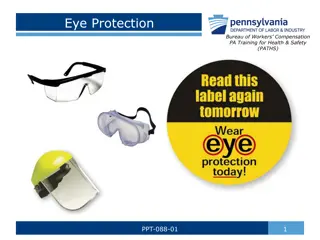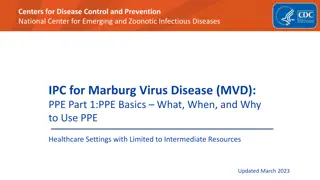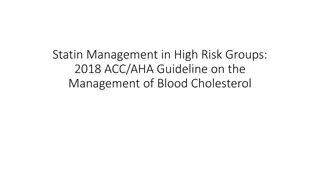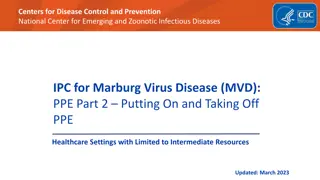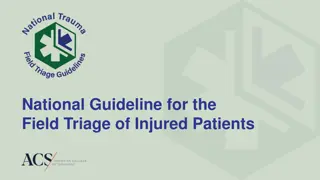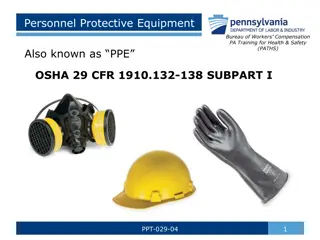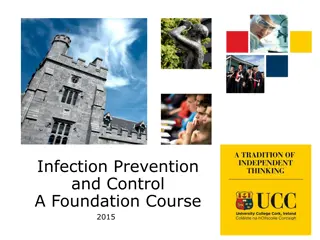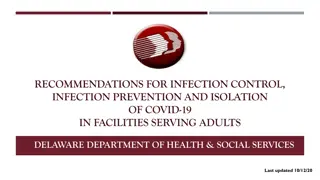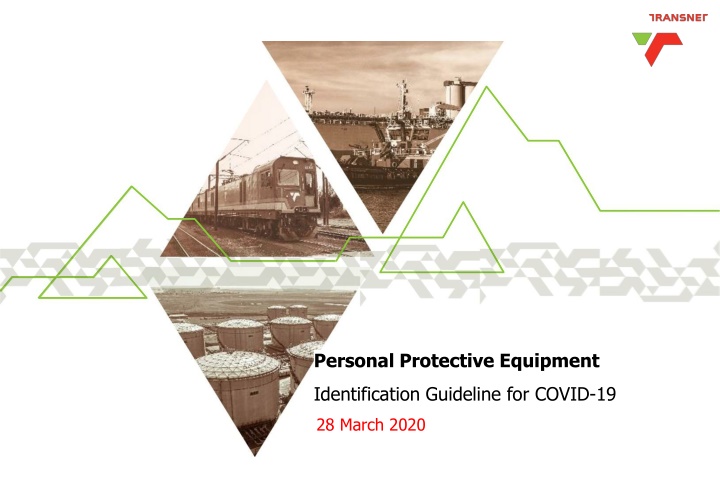
Workplace COVID-19 Risk Assessment and PPE Guidelines
Learn how to classify worker exposure to SARS-CoV-2 and implement workplace controls for COVID-19 safety. Understand the hierarchy of controls and the importance of hazard identification and risk assessment in maintaining a safe work environment.
Uploaded on | 0 Views
Download Presentation

Please find below an Image/Link to download the presentation.
The content on the website is provided AS IS for your information and personal use only. It may not be sold, licensed, or shared on other websites without obtaining consent from the author. If you encounter any issues during the download, it is possible that the publisher has removed the file from their server.
You are allowed to download the files provided on this website for personal or commercial use, subject to the condition that they are used lawfully. All files are the property of their respective owners.
The content on the website is provided AS IS for your information and personal use only. It may not be sold, licensed, or shared on other websites without obtaining consent from the author.
E N D
Presentation Transcript
Personal Protective Equipment Identification Guideline for COVID-19 28 March 2020
Contents 1. Table of Contents 2. Identifying and Implementing Workplace Controls 3. Hazard Identification and Risk Assessment 4. Classifying Worker Exposure to SARS-CoV-2 5. Potential Exposure per Employee Category 6. Current Risk Assessments need to be reviewed for COVID-19 7. Summary of Hierarchy of controls for COVID-19 Strictly private and confidential 1
2. Identifying and Implementing Workplace Controls The legislation governing workplaces in relation to COVID 19 is the Occupational Health and Safety Act, Act 85 of 1993, as amended, read with the Hazardous Biological Agents Regulations. Section 8 (1) of the Occupational Health and Safety (OHS) Act, Act 85 of 1993, as amended, requires the employer to provide and maintain as far as is reasonably practicable a working environment that is safe and without risks to the health of employees. Specifically section 8(2)(b) requires steps such as may be reasonably practicable to eliminate or mitigate any hazard or potential hazard before resorting to personal protective equipment (PPE). However, in the case of COVID 19, a combination of controls is required, although the main principle is to follow the hierarchy of controls. However, before the implementation of control measures, current risk assessments need to be reviewed and updated, taking into account the new hazards posed by exposure to COVID-19 in the workplace. This is in accordance with Section 8 (2) (d) of the OHS Act. Strictly private and confidential 2
3. Hazard Identification and Risk Assessment NOTE: TIMS Procedure 004 Operational Risk Management and Risk Assessment Register Template to be used for recording of COVID-19 Risk Assessments Strictly private and confidential 3
4. Classifying Worker Exposure to SARS-CoV-2 Very High Exposure Risk High Exposure Risk Medium Exposure Risk Lower Exposure Risk (Caution) Very high exposure risk jobs are those with high potential for exposure to known or suspected sources of COVID-19 during specific medical, post mortem, or laboratory procedures. Workers in this category include: High exposure risk jobs are those with high potential for exposure to known or suspected sources of COVID-19. Workers in this category include: Medium exposure risk jobs include: Lower exposure risk (caution) jobs include: Those that require frequent and/or close contact with (i.e. within 2 meters of) people who may be infected with SARS-CoV- 2, but who are not known or suspected COVID-19 patients. Those that do not require contact with people known to be, or suspected of being infected with SARS-CoV-2, nor frequent close contact with (i.e. within 2 meter of) the general public. Healthcare delivery and support staff (e.g. doctors, nurses, and other hospital staff who must enter patients rooms) exposed to known or suspected COVID-19 patients. Healthcare workers (e.g. doctors, nurses, dentists, paramedics, emergency medical technicians) performing aerosol-generating procedures (e.g. intubation, cough induction procedures, bronchoscopies, some dental procedures and exams, or invasive specimen collection) on known or suspected COVID-19 patients. Healthcare or laboratory personnel collecting or handling specimens from known or suspected COVID-19 patients (e.g. manipulating cultures from known or suspected COVID-19 patients). In areas without ongoing community transmission, workers in this risk group may have frequent contact with travelers who may return from international locations with widespread COVID-19 transmission. Workers in this category have minimal occupational contact with the public and other co- workers. (Note: when such workers perform aerosol-generating procedures, their exposure risk level becomes very high.) Medical transport workers (e.g. ambulance personnel and porters) moving known or suspected COVID-19 patients in enclosed vehicles. In areas where there is ongoing community transmission, workers in this category may have contact with the general public (e.g. in schools, high-population-density work environments, such as labour centers, consulting rooms, point of entry personnel and some high-volume retail settings). Strictly private and confidential 4
5. Potential Exposure per Employee Category EMPLOYEE CATEGORY WORK ACTIVITY RiRISK CLASSIFICATI ON Low Exposure Risk PPE REQUIREMENTS EQUIPMENT/MATERIAL Office Employees ( Open plan and Single offices) Day to day office based support activities in open floor setup. interactions during boardroom meetings Surgical Face Mask 70% Alcohol based sanitiser Desktop Support Technicians VISIT END USERS FOR: Support and maintenance of computer systems, desktops and peripherals. Cloth face - mask, Gloves 70% Alcohol based sanitiser Low Exposure Risk Network Technicians VISIT SITES (DATA CENTERS , OFFICE SITES etc.) FOR : Installation of computer networks, connections and cabling. Trouble shooting network failures and repairs. May Contact Security personnel to gain access to the data centers and office sites> May contact each other during duty delivery Cloth Face Mask , Gloves 70% Alcohol based sanitiser Low Exposure Risk Receptionists Interact with all visitors and keep a register of assets of visitors.ie Laptops. Low Exposure Risk Cloth Face Mask, Face Shield/Goggles, Gloves 70% Alcohol based sanitise, Alcohol based wipes Clinic Personnel Administrate the medical Surveillance programme. Clinical management of sick employees Very High Exposure Risk N95 Face Mask, Gloves, Goggles, Aprons and UV light and Screens where possible Infrared digital Thermometers 70% Alcohol based sanitiser Strictly private and confidential 5
5.Potential Exposure per Employee Category cont RISK CLASSIFICATI ON EMPLOYEE CATEGORY WORK ACTIVITY PPE REQUIREMENTS EQUIPMENT/MATERIAL Security Screen visitors and keep a register of assets of visitors.ie Laptops. Perform the alcohol testing at entrances to sites and or buildings. Search vehicles. High Exposure Risk Surgical Mask, Face Shield/Goggles, Gloves Infrared digital Thermometers 70% Alcohol based sanitiser Cleaners Cleaning of common areas in the operations as well as in offices, including desks and work areas Medium Exposure Risk Cloth Face Mask, Color Coded, Gloves, Goggles and Aprons Infrared digital Thermometers 70% Alcohol based sanitiser Site Workers Perform various operations work , i.e. maintenance, manufacturing, Run trains , etc. Low Exposure Risk Cloth Face Mask, Overalls Face Shield/Goggles Gloves Infrared digital Thermometers 70% Alcohol based sanitiser Goods Handlers at Ports of Entry Handling of good in port areas Medium Exposure Risk Surgical Face Mask, Face Shield Gloves and Goggles 70% Alcohol based sanitiser Site Based Security Screen all visitors and keep a register of assets of visitors.ie Laptops. Perform the alcohol testing at entrances to sites and or buildings. Search vehicles, and protect Transnet assets on the field or on site and in offices blocks High Exposure Risk Gloves and Surgical face Masks. 70% Alcohol based sanitiser Canteen Workers Handling of food and utensils used by staff and customers Low Exposure Risk Gloves and cloth face Masks. Infrared digital Thermometers 70% Alcohol based sanitiser Strictly private and confidential 6
6. Current Risk Assessments need to be reviewed for COVID-19 NOTE: While correctly using PPE can help prevent some exposures, it should not take the place of other prevention strategies. Engineering Controls Administrative Controls Safe Work Practices Personal Protective Equipment (PPE) Engineering controls involve isolating employees from work- related hazards. Administrative controls require action by the employee and employer. Typically, administrative controls are changes in work policy or procedures to reduce or minimize exposure to a hazard. Examples of administrative controls for SARS-CoV-2 include: Encouraging sick workers to stay at home. Minimizing contact among workers, clients, and customers by replacing face-to-face meetings with virtual communications e.g. conference calls, Skype, Microsoft Teams, etc. Minimizing the number of workers on site at any given time. Discontinuing nonessential local and international travel. Developing emergency communications plans. Providing workers with up-to- date education and training on COVID-19 risk factors and protective behaviours (e.g. cough etiquette, use and care of PPE). Safe work practices are types of administrative controls that include procedures for safe and proper work used to reduce the duration, frequency, or intensity of exposure to a hazard. Examples of safe work practices for SARS-CoV-2 include: Providing resources and a work environment that promotes personal hygiene. For example, no-touch refuse bins, hand soap, alcohol-based hand rubs containing at least 70 percent alcohol, disinfectants, and disposable towels for workers to clean their hands and their work surfaces. While engineering and administrative controls are considered more effective in minimizing exposure to SARS-CoV-2, PPE may also be needed to prevent certain exposures. In workplaces where they are appropriate, these types of controls reduce exposure to hazards without relying solely on worker behaviour and can be the most cost-effective solution to implement. The types of PPE required during a COVID-19 outbreak will be based on the risk of being infected with SARS- CoV-2 while working and job tasks that may lead to exposure. Employers are obligated to provide their workers with PPE needed to keep them safe while performing their duties. Engineering controls for SARS- CoV-2 include: Installing high-efficiency air filters (not to be relied on as the most appropriate in isolation of other controls). Increasing ventilation rates in the work environment. Installing physical barriers such as face shields. Specialized negative pressure ventilation in some settings (e.g. airborne infection isolation rooms in healthcare settings and autopsy rooms in mortuary settings). PPE include: gloves, goggles, face shields, face masks, gowns, aprons, coats, overalls, hair and shoe covers and respiratory protection, when appropriate. Requiring regular hand washing or using of alcohol-based hand rubs. Workers should always wash hands when they are visibly soiled and after removing any PPE. All types of PPE must be selected based upon the hazard to the worker. Display handwashing signs in restrooms. Blanket approach to PPE selection is not advisable and may create secondary exposure risks. Strictly private and confidential 7
7. Summary of Hierarchy of controls for COVID-19 NOTE: If the first step of the hierarchy is not practical, the employer must move to the next step and so on... Strictly private and confidential 8


